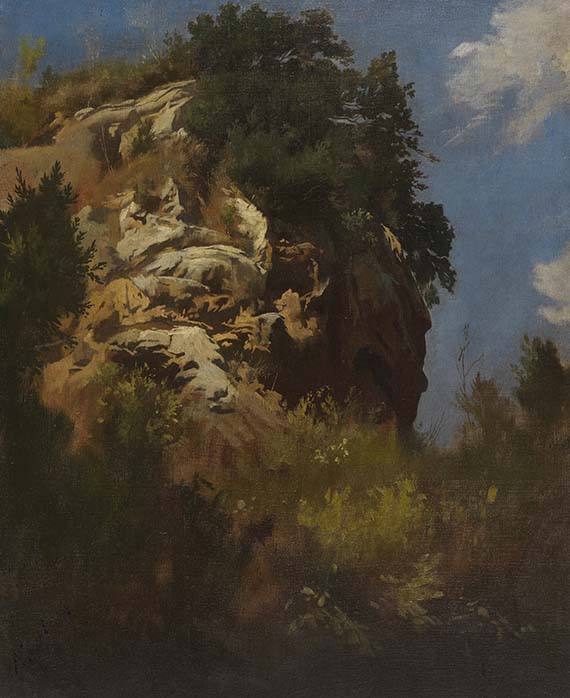Frame image
339
Anselm Feuerbach
Landschaft, Felsgestein, Um 1857/58.
Oil on canvas
Estimate:
€ 4,000 / $ 4,280 Sold:
€ 16,250 / $ 17,387 (incl. surcharge)
Landschaft, Felsgestein. Um 1857/58.
Oil on canvas.
Ecker 293. 74 x 62 cm (29.1 x 24.4 in).
PROVENANCE: Art dealer Fritz Gurlitt, Berlin.
Private collection Bavaria (family-owned since the 1920s).
LITERATURE: Hermann Uhde-Bernays, Feuerbach: beschreibender Katalog seiner sämtlichen Gemälde, Munich 1929, no. 158 (with illu.).
Fotokonvolut: Wolfgang Gurlitt-Archiv, Bildarchiv Foto Marburg, image file no. fm145146 (www.bildindex.de/document/obj20418121).
Oil on canvas.
Ecker 293. 74 x 62 cm (29.1 x 24.4 in).
PROVENANCE: Art dealer Fritz Gurlitt, Berlin.
Private collection Bavaria (family-owned since the 1920s).
LITERATURE: Hermann Uhde-Bernays, Feuerbach: beschreibender Katalog seiner sämtlichen Gemälde, Munich 1929, no. 158 (with illu.).
Fotokonvolut: Wolfgang Gurlitt-Archiv, Bildarchiv Foto Marburg, image file no. fm145146 (www.bildindex.de/document/obj20418121).
In the 1870s, Anselm Feuerbach achieved great fame as a representative of a new school of mythological-literary historical art, which he created alongside the so-called “Teutonic Romans” Arnold Böcklin and Hans von Marées. Large-scale paintings such as “Medea” (1870, Bavarian State Painting Collections, New Pinakothek, Munich) or “Iphigenie” (1871, State Gallery of Stuttgart) translate into their visual equivalent the grandiosity and sublimity he believed to have found in his adopted hometown of Rome. During his first years of study at the Düsseldorf Academy, he met famous artists like Wilhelm von Schadow, who was inspired by the Nazarenes, and Johann Wilhelm Schirmer, the paragon of Romantic landscape painting. His time at the Paris studio of the historical painter Thomas Couture also had a formative effect on him. In 1855, Feuerbach traveled first to Venice and then on to Rome, where he stayed with brief interruptions until 1872. Feuerbach searched for an idealism and a continuation of ancient sublimity which he believed to have found both in the Italian people – especially in his idolized muse Nanna – and in the nature that had survived there for centuries. His search gave rise to a number of landscapes that are imbued with a mysterious effect. Deserted and yet strangely animated in its ragged and shaded structure, towering in the heat against the blue sky, the craggy rock appears to be the perfect abode of forest and nature spirits like fauns and dryads. Feuerbach’s fellow artist in Rome, Arnold Böcklin, painted this concept in 1858/1860, with Pan hiding in the reeds or emerging from the rocks, frightening a shepherd. (New Pinakothek and Schack Collection, Munich). Lying on the ground in the shady grass, looking on, the viewer seems to be waiting for the emergence of the mystical creatures. Similar to Feuerbach’s approach in his historical paintings, the landscape – despite its dormant monumentality – becomes a turbulent vehicle of emotions, merging perceptions of reality with the ideational and the imaginative. [KT]
339
Anselm Feuerbach
Landschaft, Felsgestein, Um 1857/58.
Oil on canvas
Estimate:
€ 4,000 / $ 4,280 Sold:
€ 16,250 / $ 17,387 (incl. surcharge)




 Lot 339
Lot 339 
